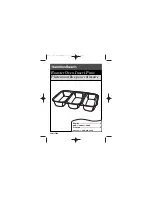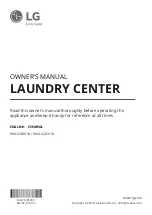
9
3.
Keep a damp cloth to hand while cooking, to
wipe up any spills as they occur, so they do not
harden and become more difficult to remove
later.
4.
If spills do become baked on, a cream cleanser
can be used. For stubborn deposits a soap
impregnated pad can be carefully used on the
vitreous enamel.
5.
Use only products recommended by the
Vitreous Enamel Association, these products
carry the Vitramel label.
6.
In the oven, spills and fat splashes are
carbonised at high temperatures: occasionally
brush out with a stiff brush. The shelves can be
soaked and cleaned with a cream cleanser.
7.
Both insulating covers should be raised and
allowed to cool before cleaning the enamel with
a soapy damp cloth. Use a wire brush to keep
the cast iron hotplate clean.
DO NOT USE ABRASIVE PADS OR OVEN
CLEANERS CONTAINING CITRIC ACID ON
ENAMELLED SURFACES. ENSURE THAT
THE CLEANSER MANUFACTURERS
INSTRUCTIONS ARE ADHERED TO.
CHIMNEY CLEANING
Whichever type of flue is chosen, there must be
cleaning access to the whole of the flue system. The
flue of the chimney will need to be cleaned regularly.
The combustion products of any oil burning
appliance will have a descaling effect on hardened
soot deposits left from burning solid fuels.
Although, the chimney may have been cleaned of
loose soot prior to installation, it is imperative that
the chimney is inspected for scaled soot particles
after the first month of operation and any loose
material removed to avoid blockage.
SERVICING
We recommend that the cooker and burner be
serviced annually by an Authorised Stanley Service
Engineer.
MILD STEEL
The steel side panels and splash back must not be
cleaned with steel wool. Use only washing-up liquid
in hot water with a lint free cloth. Dry off and apply
a coat of good quality furniture polish.
Association
OVENS
Grease spillages will burn off from the oven interior
when the oven is hot and any other loose materials
can be emptied out with a cloth when cold. Stubborn
stains in the oven and on the shelves can be
cleaned off with a paste of bread soda and water.
HOT PLATE
The hotplate may be cleaned using a small amount
of paraffin oil or fine steel wool to remove rust or
cooking stains, dry off with a lint free cloth and apply
a light coat of cooking oil to preserve the finish.
COOKING GUIDANCE
GENERAL INFORMATION
GRILLING
Turn the oven thermostat to a reasonably high
setting and this will give a greater temperature at the
top of the main oven. The roasting tin supplied with
the cooker contains a grill rack. Place any foods that
require grilling onto the rack, and place the roasting
tin as near to the top of the oven as possible. Any
gratin type recipe that requires browning, place the
dish on a shelf as near to the top of the oven as it
will allow. For a delicious breakfast, lightly grease
the base of the roasting tin and place slices of bread
with a hole cut out of the centre, onto the base,
carefully breaking an egg into each hole. Foods
such as mushrooms and halved tomatoes can be
placed around the eggs. Place the grilling rack over
the eggs and lay the bacon, sausage, black pudding
etc., onto the grilling rack. The fat will drop onto the
eggs, helping to cook and flavour them. Fatty foods
such as lamb cutlets are best suited to this method
of oven grilling, most of the fats are drawn out into
the roasting tin. Certain foods with little fat, benefit
from pan frying/dry frying on the hotplate, using a
ribbed frying or griddle pan. The foods cooked this
way look attractive with the bar markings from the
pan.
THE CARE OF YOUR COOKER
The vitreous enamel finish on your cooker is tough
and hard wearing but should be treated with care.
Acidic spills on the hob should be wiped off with a
clean damp cloth. The vitreous enamel front, sides
and hob only need a wipe with a warm soapy cloth,
then a polish with a dry one. Do not use an abrasive
cleaning material on the vitreous enamel. If there
are stubborn marks on the hob, use a good quality
enamel cleaner. Look for cleansers carrying the
VEDC (Vitreous Enamel Development Council)


































